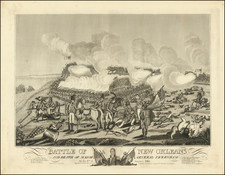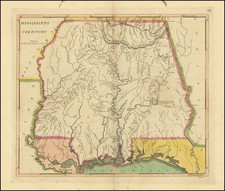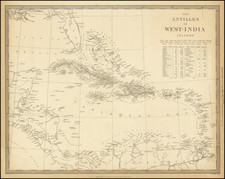Jacques Le Moyne's Landmark Map of Florida & The Southeast, Based On The Expedition of Laudonniere to Florida in 1564
Jacques Le Moyne's map of Florida and the Southeastern portion of the United States is one of the most important 16th Century maps of the region.
Le Moyne's map includes the peninsula of Florida and the surrounding regions from the northern part of Cuba to "Prom Terra falg" or Cape Lookout. The map was included in De Bry's Brevis Narratio Eorum Quae in Florida Americae Provincia.
Jacques le Moyne was an artist who accompanied Laudonniere to Florida in 1564. Le Moyne prepared this map, along with drawings and a narrative account. De Bry first attempted to obtain the information from Le Moyne in London in 1587, but Le Moyne, who was then working for Sir Walter Raleigh, refused to part with them. After Le Moyne's death in 1588, De Bry acquired his work from Le Moyne's widow and published them in 1591. Cumming surmised that the manuscript map was the source of not only this map, but was also used by John White in making the southern part of his La Virgenia Pars.
The map was a landmark for the region, containing significant new information (often inaccurate) which became a primary source for other maps for the next 150 years. It was Le Moyne's misfortune to have many of his errors incorporated and even exaggerated in Mercator's map of 1606, upon which for half a century much of the subsequent cartography of the region was based. Le Moyne's coastline is usually correct for latitude, but the shore extends too far east rather than northeast in direction. This caused a striking error in Mercator's map, with a compensating enlargement of the Virginia region; the mistake was corrected somewhat by Jansson in 1641 and those who followed him.
The sea shown at the top is probably Verrazano's Sea. A similar body of water is found in Lescarbot's map of 1611 and Seller's map of 1679. Along the coast are Latin names for rivers and bays, such as Gironda, Garumna, and Charenta, together with a few of the earlier Spanish names. While scholars have attempted to identify the rivers shown, Cumming questioned whether Le Moyne had definite knowledge of the number of rivers along the coast. The names were given on the first voyage under Ribaut, who in his account makes some reference to their latitude and appearance. They were eventually superseded by others when the seventeenth century English settlers arrived and only Le Moyne's "Portus Regalis" (Port Royal) survives.
Le Moyne's placement of Charlefort on an island at Port Royal and Carolina (the fort "la Carolina") on the River May are helpful identifications. But the name "Carolina" copied by a later mapmaker, and by Sanson 1656 (put much farther north), was probably the original source of the later false belief of mapmakers (Delisle 1718, Covens and Mortier ca.1730) and even nineteenth century historians, that the whole country was named Carolina by the French.
Le Moyne added several lakes which endured in mythological proportions in the later cartography of the Southeast. In the peninsula of Florida is a lake with an island called "Sarrop," which probably represents Lake Okeechobee. North of Sarrop is a larger lake which over time became the great inland lake of the Southeast. Le Moyne locates it slightly southeast of the mouth of "May" (St. Johns River), into which it flows. He calls it "Lacus aquae dulcis" (fresh water lake) and says that it is so large that from one bank it is impossible to see the other side. To the north of the lake, among the "montes Apalatci" (Appalachian Mountains) is another large lake, fed by an enormous waterfall. This waterfall may have been inspired by tales of waterfalls in western North Carolina; but it is more likely to depict the legends heard from Indians of the great falls of Niagara. Below this lake is written "In hoc lacu Indigenae argenti grana inveniunt" (In this lake the natives find grains of silver).
To view a short video on this map by map collector Tom Touchton, click here: https://www.youtube.com/watch?v=fmCoYxYLbEs












![[ Charleston, Boston, New York, St. Augustine, Bahamas, etc ] Particular Draughts of some of the Principal Towns and Harbours belonging to the English French and Spanish in America and the West Indies.](https://storage.googleapis.com/raremaps/img/small/102804.jpg)
![[ British Colonies in North America & Caribbean ] L'Amerique Angloise, ou Description des Isles et Terres du Roi d'Angleterre dans l'Amerique, Avec de nouvelles Carte de chaque Isle & Terres](https://storage.googleapis.com/raremaps/img/small/102812.jpg)
